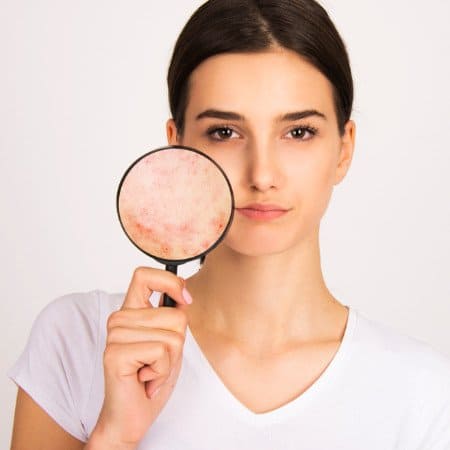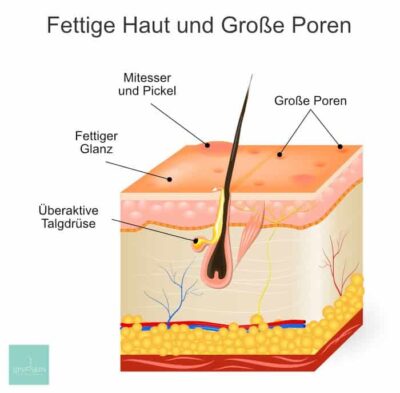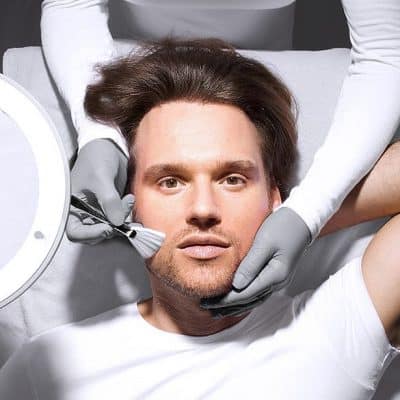Botox in the Skin for a Flawless Complexion
You’re wondering: What can be done about large pores? On the nose? On the cheeks? How can I refine my pores? And get rid of the oily skin around them? My answer is: Botox.
You heard it right: Botulinum toxin A, the well-known anti-wrinkle treatment, can also effectively reduce large pores. It can even improve acne-prone skin. This procedure is called Skin Botox and originates from South Korea. In this technique, a higher dilution of botulinum toxin is injected, not into the muscles, but into the skin. It targets the pores and reduces sebum production.
By improving oily skin, Skin Botox indirectly supports acne treatment. Oily skin often contributes to the development of acne. However, the use of Botulinum toxin as a complementary therapy for acne is still not widely known.
In this article, I will explain how Skin Botox can help in reducing large pores and improving oily skin.
Here are the topics covered:
Reduce Large Pores with Skin Botox
What Causes Large Pores?
What is Skin Botox?
The Treatment Process
What Is the Cost of Skin Botox?

Reduce Large Pores with Skin Botox
First, I want to clarify that I am not a dermatologist. Therefore, if you have severe acne, I strongly advise you to consult your dermatologist before considering any cosmetic treatments for large pores and blemished skin. Especially in cases of advanced and inflammatory acne, the measures described in this article alone will not lead to success. In such cases, it is crucial to seek the advice of your dermatologist.
Skin Botox, Micro-Botox, Meso-Botox
Now let’s get to our topic: Large pores and oily skin (medically known as seborrhea) can often be effectively treated with botulinum toxin. The procedure, as mentioned above, is relatively new. In fact, it is so new that there is no definitive name for it among medical professionals. Some refer to it as “Micro-Botox” (which I initially did), others call it “Meso-Botox,” and still, others refer to it as “Skin Botox.” The term “Skin Botox” has also become widespread in Germany, which is why I will use it throughout the rest of this article. However, you may come across the term “Micro-Botox” on other parts of my website. Please do not be confused; both terms refer to the same therapy.
Skin Botox for Seborrhea
However one may refer to it, the therapy of seborrhea with botulinum toxin is both intriguing and promising. Large pores on the face, often accompanied by blemished and oily skin, are a widespread issue and a direct precursor to acne. However, seborrhea alone is not a sole cause of acne. As long as the excess sebum produced by the sebaceous glands in seborrhea is not decomposed by bacteria and enzymes, inflammations that characterize the typical appearance of acne are infrequent. More on this below.
Creams and Lotions Often Do Not Help
The treatment of oily skin is one of the numerous new applications of botulinum toxin that medical professionals have discovered recently. The focus of botulinum injections has shifted from muscles to the skin, opening up an entirely new range of therapeutic possibilities. Refining pores and improving blemished skin, characteristic of acne-prone skin, are just two of the therapeutic goals that can be successfully pursued with it. Another goal includes reducing excessive sweating. Botulinum toxin can improve blemished skin more effectively than many of the well-known acne home remedies and creams.
All cosmetic products and measures that aim to reduce pore size from the outside, in fact, cannot do anything to decrease increased sebum production. However, that’s precisely what matters! Creams, tinctures, and lotions may, at best, temporarily refine pores and have more of an optical rather than an actual effect (referred to as an astringent effect). They do not address the root cause of the problem.
Oily Skin Due to Excess Sebum Production
If it doesn’t inhibit excess sebum production, no treatment can reduce pore size or improve blemished skin. Until now, your dermatologist could only prescribe a medication called Isotretinoin, which is regularly proven to be highly effective but unfortunately often comes with severe side effects. Botulinum toxin, in the form of Skin Botox, can also reduce large pores, as newer studies show. And it does so without side effects. Therefore, it is worth discussing with your dermatologist the possibility of using botulinum toxin to treat large pores and mitigate existing acne without any side effects.
Skin Botox is Injected Into the Skin
Because in this application, botulinum toxin is not injected into the muscle but only into the skin above it, facial expressions remain completely intact. There is no risk of facial features being affected or frozen. Botulinum toxin is not administered in this application to relax muscles but rather to utilize the neurological mechanism of the toxin to specifically reduce sebum production and, consequently, shrink the pores.
What Causes Large Pores?
Oily skin and large pores often occur together. Oily skin, also known as seborrhea, refers to the increased production of lipids (sebum) by the sebaceous glands, resulting in a higher lipid content on the skin surface. Seborrhea is widespread and typically begins during puberty, persisting into adulthood for many individuals. Men are more prone to oily skin and, as a direct consequence, more likely to experience acne. However, it is primarily women who seek cosmetic-medical assistance for seborrhea and acne, likely influenced by prevailing beauty ideals that encourage them to strive for “peachy skin” and refined pores.
Seborrhea and Acne Can be Burdensome
Seborrhea and acne are conditions that can cause distress for those affected, both personally and professionally. Studies have shown, for example, that individuals with acne face greater challenges in finding suitable employment. Moreover, oily skin prone to acne affects many teenagers during puberty, a time when they are already dealing with significant social and psychological changes. Depression and suicidal thoughts are therefore not uncommon, and have been reported more frequently in relation to acne. It’s no wonder that drugstores now boast entire shelves dedicated to combating adolescent acne.
What Exactly is Seborrhea?
As mentioned earlier, seborrhea is not synonymous with acne. The clinical appearance of seborrhea is characterized by shiny, oily skin with large pores. However, seborrheic skin is often associated with the development of acne. In acne, in addition to shiny skin, comedones (blackheads) and inflammatory skin changes in the hair follicles can occur in hairy areas. Comedones that are completely blocked beneath the skin surface are often only noticeable through the sebum’s translucence, appearing as small whitish papules (pimples).
Pimples and Blackheads
If, on the other hand, the follicle opening is not completely closed, then dirt and melanin form a black-appearing plug (“blackhead”). Usually, both occur together and often enough they tend to become inflamed. As a long-term consequence, the formation of comedones leads to damage to the connective tissue and significant enlargement of the follicle, and thus ultimately to the appearance of “large pores”. So large pores don’t just look dilated – they actually are. Considering this circumstance, I would like to take this opportunity to once again advise all those affected to visit their dermatologist in good time in order to counteract the development described above at an early stage. Your dermatologist may be able to do more than just refine pores and fix other externals, possibly halting the progression of the disease as such.
Causes of Seborrhea
Seborrheic skin is primarily attributed to hormonal causes, particularly the body’s response to androgens (male sex hormones). During puberty, the influence of androgens leads to an increase in the volume of the sebaceous glands and an elevation in sebum production.
Sebum Production for Normal Skin

Normally, sebaceous glands produce a certain amount of sebum, then burst and pour their contents into the pore hair channel. During the next 6 days, the sebum rises to the exit of the pore channel, from where it emerges onto the skin surface, keeping the skin supple and protected from pathogens.
Sebum Production in Seborrhea and Acne
However, in response to androgens, the sebaceous gland cells produce too much sebum. There is an excessive amount of sebum in the pore channel, which provides an ideal breeding ground for fat-loving pathogens such as Propionibacterium acnes or Coryne bacteria.
They metabolize sebum, breaking it down into different fatty acids. These in turn irritate the sensitive inner wall of the pore and stimulate it to produce new wall cells. When the mixture of dead pore cells and excess sebum clogs the pore, pimples and blackheads appear.
Increased Seborrhea During Menstruation
The dermatologist often detects a similar effect in women before menstruation, who then suffer from increased signs of acne. For example, in a study of women with oily and acne-prone skin, it was found that the maximum secretion of their sebaceous glands occurred in the week before menstruation.
In addition to hormonal causes, external factors can also lead to increased sebum production, resulting in oily skin and large pores. These include UV radiation, increased body temperature, stress, and irritation caused by certain chemicals. On the other hand, it has not yet been clinically proven that increased sweat production and diet composition also contribute to seborrhea, as is often assumed. So whether you eat a vegan diet in the future or continue to eat greasy foods has no direct effect on whether your sebaceous glands normalize and your pores shrink.
What Helps Against Oily Skin?

First things first: When it comes to cosmetic measures against seborrhea, thorough yet gentle skin cleansing and care can certainly help. You don’t even need to consult your dermatologist for that.
Important: Gentle Cleaning
Mild syndet cleansers, which are available in drugstores, are well-suited for cleansing seborrheic skin. Such cleansing products help remove excess sebum, dirt, and dead skin cells. Similarly, specialized cleansers from well-known cosmetic brands, often marketed as “cleansers,” have the same effect.
I want to explicitly warn against drying creams and lotions at this point. These usually only damage the skin’s natural barrier function without directly affecting sebum production. This can lead to a paradoxical situation where the skin becomes both dry and oily, disrupting its balance entirely.
Non-Comedogenic Makeup
If you use makeup, it is essential to make sure that it is non-comedogenic. This means that its composition does not further clog the already strained pores.
Cosmetic Treatments That Help
Additional measures that your dermatologist or esthetician can use to help with seborrhea include microdermabrasion, enzyme peeling, and light fruit acid peels. A HydraFacial is also well-suited for this purpose. All of these treatments remove dead skin cells and reduce problems with hyperkeratosis. They can help minimize large pores to a limited extent, but not permanently. So, what can you do? Let’s now take a look at what Skin Botox is and how it helps with blemished skin and large pores.
What Is Skin Botox?
As mentioned earlier, Skin Botox uses conventional Botulinum toxin A, which is also used for wrinkle treatments. However, in contrast to wrinkle treatments, the toxin is diluted 3-4 times more and injected into the skin instead of the muscles.
In conventional wrinkle therapy, typically 0.1ml of solution and 4 units of Allergan toxin are injected per injection point. In Skin Botox, the dosage is reduced to a maximum of 0.05ml of solution and 0.7 units of Allergan toxin per injection point.
Due to the higher dilution, the active ingredient spreads around the injection point, distributing the Botulinum toxin within the skin. By injecting into the skin in a grid-like pattern with injection points approximately 1 cm apart, a larger area of the skin can be treated.
Discovered by Chance
Skin Botox was actually discovered by chance. American dermatologist Anil Shah, who first reported in 2008 that Botulinum toxin can reduce large pores and improve oily skin, initially treated his patients for “bunny lines” (nasal wrinkles). Some of them then happily reported back that not only the wrinkles on the bridge of their nose had improved but also their skin texture. Dermatologists in South Korea further developed this new insight into an independent therapy.
Effectiveness Supported by Studies
With a highly diluted Botulinum toxin solution, large pores can be reduced, and oily skin can be significantly improved. And unlike most cosmetics, this is achieved through an actual reduction in sebum production.
Studies supporting these findings have been conducted since 2008. Their results are convincing both objectively and subjectively: The authors observed a significantly lower sebum production of 50 to 75% and scientifically demonstrated its reduction. Objectively, Skin Botox is therefore suitable for reducing large pores.
But equally important, over 90% of the study participants were very satisfied with the visual results. And for practitioners like me, this is the most important aspect. After all, patients invest significant costs and efforts to feel more comfortable in their skin than before.
Unclear Mechanism of Action
The exact mechanism by which Botulinum toxin reduces sebum production in the skin remains unclear until now. It is believed, however, that the toxin affects the muscles responsible for erecting the hair (the so-called “arrector pili muscles”) and the receptors of the sebaceous glands that respond to androgens (the so-called “muscarinic acetylcholine receptors”).
The Treatment Process
Reducing large pores with Baby Botox is performed in my practice in the same way as any other botulinum toxin treatment:
- A detailed self-disclosure of the patient is required to reveal possible contraindications.
- In the subsequent patient interview, the possibilities of the therapy are discussed, as well as the risks and possible side effects.
- The status quo is then documented by photo.
- For the subsequent injections, I use the thinnest needles currently available on the market. The punctures are made at an angle of about 45 degrees obliquely into the skin surface. They are hardly noticeable. However, most patients are sensitive to the nose. And during this treatment there are sometimes 10–15 punctures and more on both sides of the nose. Therefore, I usually numb the nose with the local anesthetic lidocaine before the injection.
After treatment, patients can typically resume their normal activities with no downtime. The redness of the skin at the injection sites should have disappeared by then. Slight wheals at the injection points may still be visible, but they will also disappear a short time later.
Skin Botox and Microneedling
Microneedling is an alternative technique to inserting Baby Botox into the skin. Microneedling involves puncturing the skin with numerous needle pricks, to a depth of 1.5 mm. Through the microchannels created in this way, the highly diluted botulinum toxin can penetrate the dermis and take effect there. This type of treatment has several advantages over injections, but it is pricier.
For the days after the treatment, the same advice applies as for the classic BOTOX injection: don’t do any sports or heavy activities, avoid sauna and solarium, take precautions against UV radiation with a high sun protection factor (SPF 50).
What is the Cost of Skin Botox?
The use of Botulinum toxin A for treating large pores and excessive sebum production is considered an off-label use, meaning the specific drug is not officially approved for this type of application. As a result, the doctor-patient discussion during the informed consent process is particularly crucial. Cost considerations also need to be addressed and communicated to the patient in advance.
In a limited area such as the nose, it is relatively easy to estimate the price, even if it is ultimately billed based on the German Medical Fee Schedule (GOÄ) on an individual basis. The complexity of the individual case and the number of injection points play an important role in determining the cost.
In my practice in Munich, I typically charge for a whole vial of Vistabel, even if it is not entirely used for the treatment of large pores. In such cases, any remaining quantity may be recommended for a traditional wrinkle treatment in other facial regions, if appropriate and desired. Otherwise, any remaining product is discarded, as I do not store partially used vials for hygiene reasons.
The price for a Skin Botox treatment in my practice is approximately €290 (indicative value, individual billing will follow the GOÄ). This allows for the treatment of a large area with the triple dilution. If you prefer to combine the treatment with microneedling, the total cost would be around €500 (indicative value).

